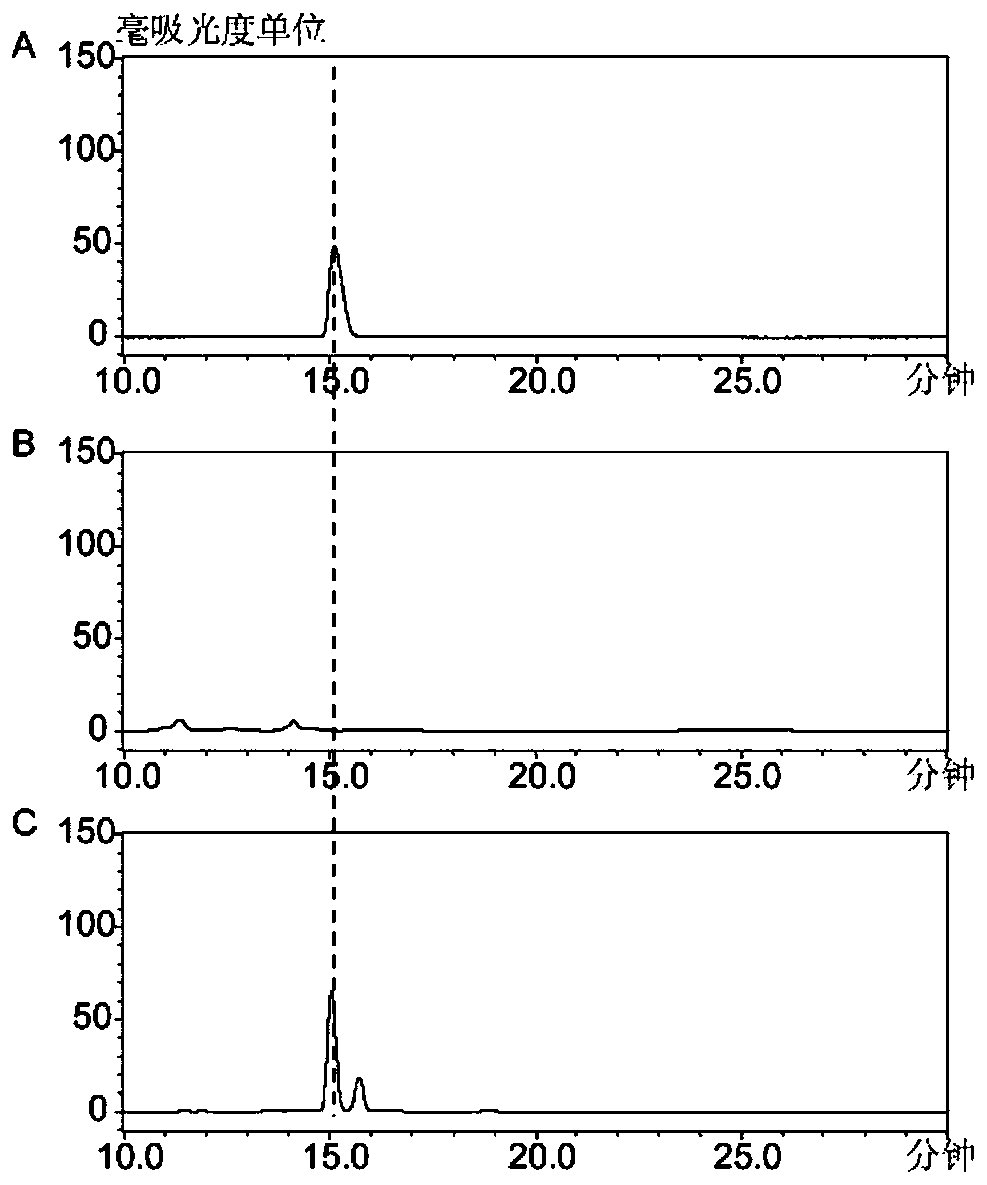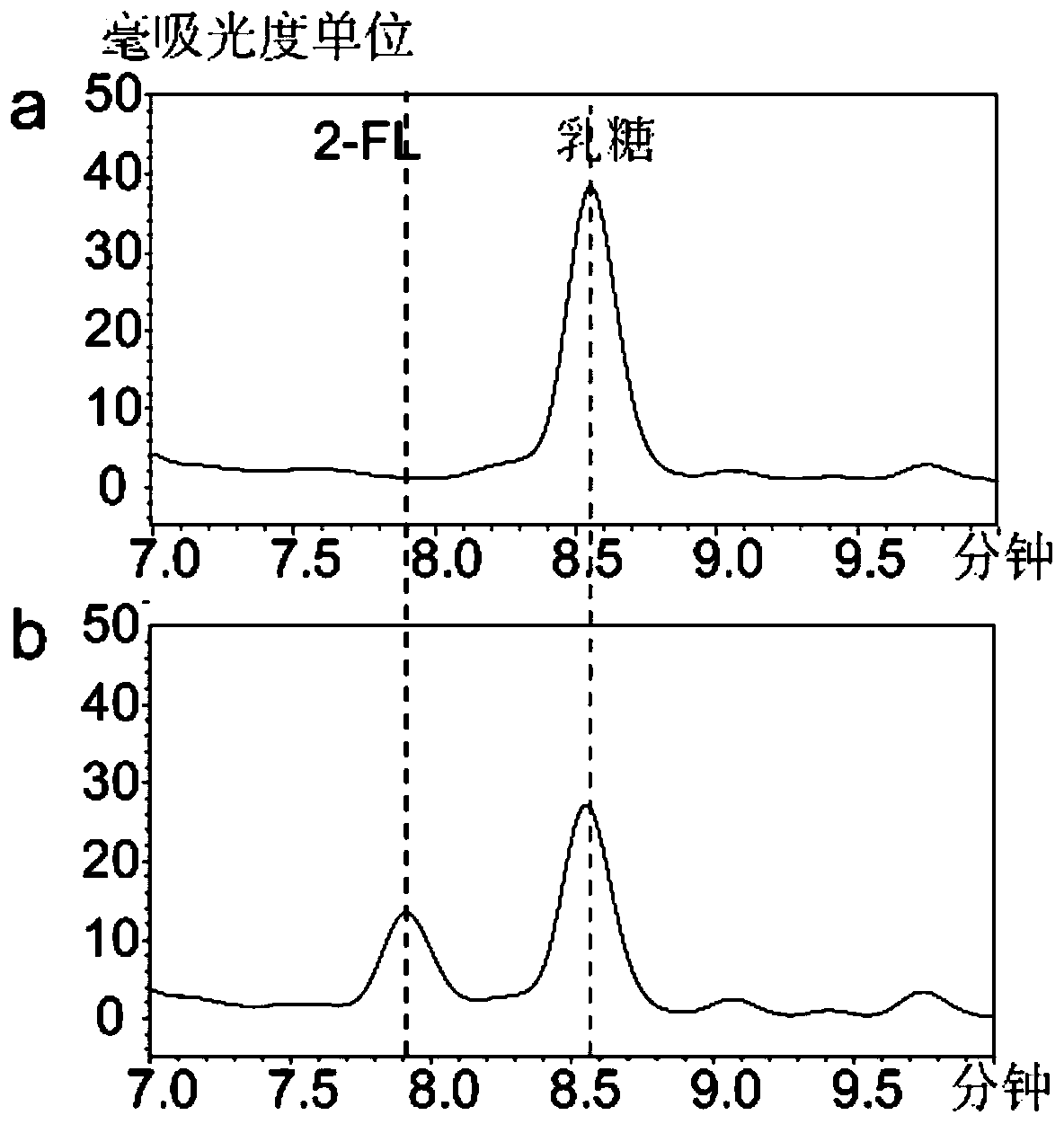Saccharomyces cerevisiae engineering strain with high yield of fucosyllactose and application of saccharomyces cerevisiae engineering strain
A technology of fucosyllactose and Saccharomyces cerevisiae, which is applied in the field of genetic engineering, can solve the problems of difficulty in meeting industrial production, industrial production constraints, affecting the difficulty of product separation and purification, and product safety.
- Summary
- Abstract
- Description
- Claims
- Application Information
AI Technical Summary
Problems solved by technology
Method used
Image
Examples
Embodiment 1
[0027] Example 1: Construction of recombinant genetically engineered strain of Saccharomyces cerevisiae that can absorb lactose
[0028] The construction of the recombinant engineering strain in this example uses Saccharomyces cerevisiae W303-1a as the starting strain.
[0029] The total DNA of Kluyveromyces lactis was extracted with Omega kit, and the sequence of lactose permease was amplified from it using primers Lac12-F and Lac12-R, named Lac12, its amino acid The sequence is shown in SEQ ID No.1, and the nucleic acid sequence is shown in SEQ ID No.2.
[0030] Using the total DNA of Saccharomyces cerevisiae W303-1a as a template, using BamHI-GAL1-F and GAL1-LAC12-R as primers to amplify the gal1 promoter, using lac12-CYC1-F and CYC1-XhoI-R to amplify Generate cyc1 terminator, construct P by SOE-PCR gal1 -lac12-T cyc1 The expression cassette was seamlessly connected to the pRS304 vector after double digestion with BamHI and XhoI to obtain the recombinant vector pRS304-P gal1 -la...
Embodiment 2
[0036] Example 2: Construction of a recombinant Saccharomyces cerevisiae genetically engineered strain producing GDP-fucose
[0037] From Escherichia coli K12, the GDP-mannose dehydratase (GDP-mannose-4,6-dehydratase) sequence was amplified with primers GMD-F and GMD-R, named Gmd, and its amino acid sequence is as SEQ ID No. 3 is shown, and its nucleotide sequence is shown in SEQ ID No. 4. The sequence of GDP-L-fucose synthase (GDP-L-fucose synthase) was amplified with primers WcaG-F and WcaG-R, named WcaG, its amino acid sequence is shown in SEQ ID No. 5, and its nucleotides The sequence is shown in SEQ ID No.6.
[0038] The pUMRI-A plasmid (Ye, L., X.Lv, and H. Yu, Assembly of biosynthetic pathway in Saccharomyces cerevisiae using a marker recyclable integrative plasmidtoolbox.Frontiers of Chemical Engineering in China, 2017.11(1): p.126-132 .) is a template, wcag-10-F and 10-gmd-R are primers to amplify bidirectional promoter gal1,10. Using the total DNA of Saccharomyces cere...
Embodiment 3
[0043] Example 3. Construction of a genetically engineered strain of recombinant Saccharomyces cerevisiae producing 2'-fucosyllactose
[0044] Using human and Helicobacter pylori-derived α-1,2-fucosyltransferase as a template, new strains of Helicobacter pylori, Acetobacter sp., Bacillus cereus, Bacteroides unifomis, Bacteroides eggerthii, Neocallimastix californiae were discovered by blast analysis α-1,2-fucosyltransferase, respectively named Futhp (amino acid sequence is shown in SEQ ID No. 7, nucleotide sequence is shown in SEQ ID No. 8), Futas (amino acid sequence is shown in SEQ ID No. 9, the nucleotide sequence is shown in SEQ ID No. 10), Futbc (the amino acid sequence is shown in SEQ ID No. 11, the nucleotide sequence is shown in SEQ ID No. 12), Futbu (amino acid The sequence is shown in SEQ ID No. 15, the nucleotide sequence is shown in SEQ ID No. 16), Futbe (the amino acid sequence is shown in SEQ ID No. 13, and the nucleotide sequence is shown in SEQ ID No. 14) , Futnc...
PUM
 Login to View More
Login to View More Abstract
Description
Claims
Application Information
 Login to View More
Login to View More - R&D
- Intellectual Property
- Life Sciences
- Materials
- Tech Scout
- Unparalleled Data Quality
- Higher Quality Content
- 60% Fewer Hallucinations
Browse by: Latest US Patents, China's latest patents, Technical Efficacy Thesaurus, Application Domain, Technology Topic, Popular Technical Reports.
© 2025 PatSnap. All rights reserved.Legal|Privacy policy|Modern Slavery Act Transparency Statement|Sitemap|About US| Contact US: help@patsnap.com



